Toenail fungus is an infectious disease caused by pathogenic microorganisms that live in the spaces between the skin, toes, and nail plates.It causes significant discomfort and serious complications.Let’s take a closer look at how to treat foot fungus to prevent the condition from becoming chronic and to prevent recurrence.
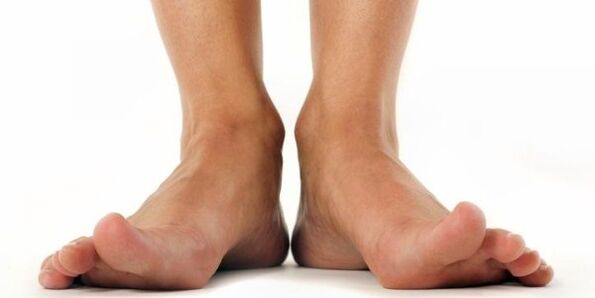
Causes and symptoms of foot fungus
The disease is caused by spores of Trichophyton rubrum and other yeasts and molds..Under favorable conditions, they multiply rapidly, causing the condition of the legs to rapidly deteriorate.
Doctors have identified several factors that contribute to the development of disease-causing microbiota:
- weakened immune system;
- Excessive sweating of feet;
- Shoes are not the right size;
- Corns, calluses, scratches on feet;
- Chronic infections and endocrine diseases;
- long-term antibiotic use;
- lack of sanitation;
- Wear non-breathable shoes made of man-made materials;
- flatfoot.
Children are more susceptible to fungal infections.Their immunity is not yet fully developed and the skin on their feet is too thin, making it easy for fungi to invade the body and begin to multiply.
When the skin on your feet becomes infected, unpleasant symptoms can quickly appear.Most commonly, the primary infection occurs in the space between the toes and gradually spreads throughout the foot.Many pathogens can also affect the nail plate, leading to the development of onychomycosis (nail fungus).
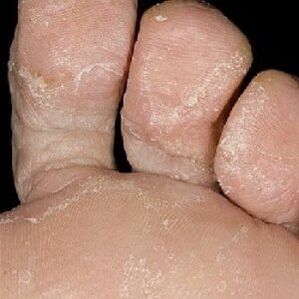
The pathology has several stages, which are characterized by certain physical signs.
- The initial stages are hidden, felt by slight peeling between fingers, and rarely taken seriously.
- Small cracks then form and the peeling intensifies and smoothly covers the sides of the foot.The skin is covered with small scales and scaly mycosis occurs.
- Symptoms gradually worsen.Itching and burning sensation occur, and the affected area becomes thick and rough.When the fungus becomes hyperkeratotic, the epidermis loses its elasticity and a clear skin pattern appears on it.The burning sensation between my fingers intensified.
- If the intertriginous stage begins, the disease usually affects the nails.Yellowish-brown spots appear on it, deformed and broken.Patients are often bothered by an unpleasant odor emanating from their feet.The skin peels off, forming small ulcers and deep cracks, causing pain when walking.
Advanced forms of the disease cause a rash between the fingers and on the feet.Small, dense bubbles often merge with each other.When they burst, the weeping wounds remain in place and can be extremely itchy.
route of infection
Fungal spores can survive in the environment for long periods of time, making it easy to contract disease in the most unexpected places.But the conditions most favorable for their development are warmth and high humidity.
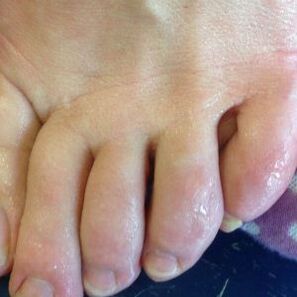
Therefore, people visiting the following locations are at risk:
- swimming pool;
- bathroom;
- sauna;
- fitness center;
- beach.
Even with regular disinfection, fungus can develop on anything there.Therefore, avoid common objects in these areas and be sure to bring replacement shoes.
Military personnel are at risk.Most often, army soldiers wear uncomfortable shoes that do not allow air to pass through them.As a result, the feet sweat, microtrauma occurs, and fungi can penetrate into them.
There are two types of infections.The first is direct contact with infectious agents while communicating with sick people, caring for animals, or walking barefoot on the ground and sand.The second is the indirect route, through items belonging to infected people or pets.
diagnosis
For successful treatment of fungus, consultation with a dermatologist is required.The specialist will perform a visual inspection and carefully examine the lesion.
In order to make a correct diagnosis, it is important to tell the doctor all alarming symptoms and report previous fungal diseases and other diseases.
To accurately determine the presence of infection and the type of pathogen, doctors must take blood, nail or skin scrapings for analysis.Laboratory tests must be performed without error.More than 500 fungal species have different resistance thresholds and require different treatment strategies.
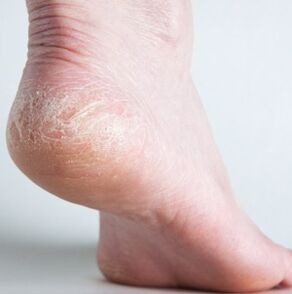
- Microscopic examination reveals the presence of fungi.Samples are treated with special preparations and examined under a microscope to try to find spores.This test allows you to determine the presence of fungus and its concentration.
- Bacterial culture provides more accurate results.Place the biological material in a nutrient medium.If pathogenic cells are present in the scrapings, fungal colonies will begin to grow from them and will need to be carefully examined.Analysis takes 2 days to 4 weeks.The time depends on the type of infection.
- PCR (Polymerase Chain Reaction) is necessary to identify specific fungal types by identifying the pathogen's DNA.This requires scraping from the affected area.Test performance is approximately 100%.
- Enzyme-linked immunosorbent assay (ELISA), collected from a vein, allows you to identify antibody titers to a specific pathogen and find the exact cause of the disease.
If you have any changes in your skin condition, you should go to the hospital.Even minor flaking and itching between fingers cannot be ignored.Otherwise, the disease will spread to the feet and nails, making it more difficult to cure.
treat
Fungus on the feet requires comprehensive treatment.The intensity of treatment depends on the type of infection and the extent of damage to the skin and nails.
Treatment includes internal and external medications and good hygiene.It is suitable to use traditional medical remedies as an auxiliary method.
drug
The treatment plan should be formulated by the doctor based on the patient's clinical condition.For the treatment of adults, medications are used in capsules or tablets, antifungal creams and ointments.Control methods aim to eliminate pathological microorganisms and heal the skin.Medication should not be stopped until full recovery is achieved..
cream
Creams are effective in treating fungus.They are lightweight and absorb quickly.When choosing a product, you need to consider contraindications for use and follow the recommendations of experts.
The cream should be applied regularly after washing the skin thoroughly with laundry soap and drying it.
ointment
There is a wide range of antifungal creams to choose from.Allergic reactions and other side effects should be ruled out before starting treatment.
If a foot fungal infection is complicated by a secondary infection and other treatments fail to achieve the desired results, a dermatologist will prescribe a corticosteroid-based ointment.
Medications can quickly relieve inflammation and stop the disease at any stage, but have many contraindications.It must be taken strictly according to the instructions and no overdose is allowed.
An effective way to eliminate all signs of fungus is to use salicylic acid ointment.This is a simple and inexpensive drug that can be used in two ways:
- Treat the affected area 3 times a day;
- Before going to bed, apply the product under the bandage and leave it on overnight.
After compression, the skin may peel and peel off a lot.You can easily get rid of such symptoms by taking a soda bath (1 tablespoon of soda per 1 liter of hot water).This procedure should be performed every other day throughout the course of treatment.
pill
In order to improve the therapeutic effect, topical medications are often combined with internal medications.Tablets have strong effects on the entire body and should not be taken without restraint.
It is recommended to treat onychomycosis with fungistatic and fungicidal drugs to inhibit the growth of fungal colonies and destroy the pathogenic flora.
The list of antifungal drugs is diverse.Your dermatologist may recommend various medications based on your medical history and symptoms.Doctors set admission rules.You must strictly follow his instructions.
folk remedies
You can recover faster using traditional methods as additional therapy.To get rid of foot fungus, use:
- Take a hot bath;
- homemade ointments;
- compression;
- Herbal Lotion.
Before treatment, it is important to ensure that the individual does not have intolerances to ingredients in traditional recipes.
fungus ointment
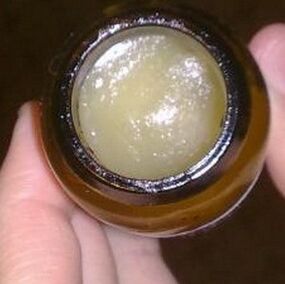
Homemade ointments can help fight pathogenic bacteria.
- Mix copper sulfate, yellow sulfur and goose fat in equal proportions in an enamel container and stir well.Heat over low heat, bring to a boil and close.The mixture needs to be cooled and transferred to a glass jar.Store in a cool, dark place.Apply to affected areas morning and night until all symptoms disappear.
- You can prepare a simpler recipe.You need to get goose fat and wood ash in equal proportions.Knead ingredients together until smooth.Use twice daily, applying generously to affected areas.
Compresses and masks
- Onion and garlic masks are a great way to treat fungus.You need to peel 2-3 cloves of garlic and a small onion.Grind the pulp and apply a thick layer on the affected skin.Cover with cellophane, bandage and put on socks.It is recommended to perform the procedure in the evening and keep the mask until the morning.After waking up, the bandage should be removed and the body should be washed with water.Treatment should be given daily until recovery occurs.
- A mixture of celandine and tea tree oil can be used as a compress.Add oil to a tablespoon of crushed dry vegetable stock.You should get a thick paste.It is necessary to apply it to the place where the fungus is located, wrap the legs with polyethylene and insulate them.Apply heat at night regularly for at least two weeks.
- An effective base for compresses is obtained from herbs.You will need to pour 400ml of sunflower oil or olive oil into the pan.Add 1 tablespoon each of calendula, mint, comfrey, and rosette.Put on fire and heat to 60 degrees.Close and place in a dark place for a day.Then filter.Apply the oil mixture for 1 hour, 2 times a day.The method is mild and can therefore be used to treat children, provided they are not allergic to the herb..
bathing place
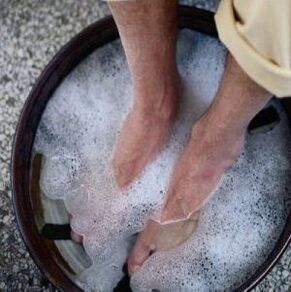
- The simplest foot fungus bath is made with salt and baking soda.You need to dissolve the ingredients in warm water in the ratio of 1 spoon of soda and 1 spoon of salt per 1 liter of water.Soak your feet in the liquid and leave it there for 15 minutes.Finally, rinse the limbs under the tap and allow them to dry.
- The herb milkweed is suitable for preparing body washes.You need to measure out 3 tablespoons of hay and pour 3 liters of boiling water over it.Wrap in a towel and leave for 4 hours.Strain, heat slightly and pour into a bowl.Leave your feet in the liquid for about half an hour.The frequency of this procedure is 1 every 2 days.Duration 1 month.
- Strong coffee inhibits the development of pathogenic spores.You will need to brew a drink (1 tablespoon ground coffee per 250 ml of water).When it has cooled to a comfortable temperature, pour it into a basin and leave your feet in the basin for 20 minutes.It is important that the area affected by the fungus is covered with water.Treatment can be done once a day for an extended period of time.
Herbal lotions and lotions
Many herbs have significant antifungal effects.To treat foot fungus, it is useful to use healing herbs.
You will need:
- marigold;
- oak bark;
- Dried blackberries;
- Verbena herb.
The ingredients must be mixed in equal proportions.Take 3 scoops of the mixture, add 500 ml of water and place in a water bath.Boil for 20 minutes, cool and strain.Wash your feet and toes with Chinese herbal decoction 2-3 times a day and apply lotion to the affected area for half an hour.

Propolis alcohol tincture helps fight disease.It can be purchased at pharmacies.Soak gauze in the liquid and apply it to the feet for 30 minutes or wipe the affected area with a cotton swab, 3 times a day.
prevention
Foot fungus is an insidious condition that requires serious treatment.To reduce the possibility of infection, appropriate precautions need to be taken.It is recommended to follow simple rules:
- Avoid high humidity;
- Don’t try on other people’s shoes;
- Maintain foot hygiene.
Controlling sweating is important.For this, you can use ordinary talc.To keep your skin healthy and not cracked, you need to lubricate it regularly with moisturizer and take a baking soda bath once a week.
During treatment, bedding should be boiled and socks should be changed daily and washed thoroughly with hot water.Nail art accessories must be systematically disinfected.To prevent reinfection, treat the inside of the shoes with vinegar or medical alcohol.
















